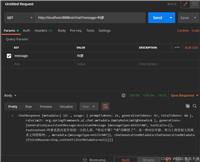微信扫码登录的具体流程涉及多个步骤,从前期的配置到后端代码的实现,下面详细介绍每个步骤:
1. 注册和配置
- 注册微信账号:首先在微信注册一个账号。
- 获取应用的 appid 和 appsecret:在微信上创建应用后,你会得到 appid 和 appsecret,这两个值在后续步骤中会用到。
- 配置授权回调域:在微信设置中,配置授权回调域名。这个域名是微信在用户授权后回调的地址,例如
yourdomain.com。
2. 前端代码准备
在前端页面上添加一个按钮或链接,让用户点击后开始微信扫码登录流程。
<a href="/wechat/login" rel="external nofollow" >微信登录</a>
3. 后端代码实现
3.1 配置项目
首先,在 application.properties 文件中添加微信应用的配置:
wechat.app-id=your_app_id wechat.app-secret=your_app_secret wechat.redirect-uri=http://yourdomain.com/wechat/callback
3.2 创建微信扫码登录控制器
package com.example.demo.controller;
import org.springframework.beans.factory.annotation.value;
import org.springframework.stereotype.controller;
import org.springframework.ui.model;
import org.springframework.web.bind.annotation.getmapping;
import org.springframework.web.client.resttemplate;
import java.util.uuid;
@controller
public class wechatlogincontroller {
@value("${wechat.app-id}")
private string appid;
@value("${wechat.app-secret}")
private string appsecret;
@value("${wechat.redirect-uri}")
private string redirecturi;
@getmapping("/wechat/login")
public string wechatlogin() {
string state = uuid.randomuuid().tostring();
string wechaturl = "https://open.weixin.qq.com/connect/qrconnect?appid=" + appid
+ "&redirect_uri=" + redirecturi
+ "&response_type=code&scope=snsapi_login&state=" + state;
return "redirect:" + wechaturl;
}
@getmapping("/wechat/callback")
public string wechatcallback(string code, string state, model model) {
string tokenurl = "https://api.weixin.qq.com/sns/oauth2/access_token?appid=" + appid
+ "&secret=" + appsecret
+ "&code=" + code
+ "&grant_type=authorization_code";
resttemplate resttemplate = new resttemplate();
wechataccesstokenresponse response = resttemplate.getforobject(tokenurl, wechataccesstokenresponse.class);
if (response != null) {
string userinfourl = "https://api.weixin.qq.com/sns/userinfo?access_token=" + response.getaccesstoken()
+ "&openid=" + response.getopenid();
wechatuserinfo userinfo = resttemplate.getforobject(userinfourl, wechatuserinfo.class);
model.addattribute("user", userinfo);
return "userprofile";
}
return "error";
}
static class wechataccesstokenresponse {
private string accesstoken;
private string openid;
// getters and setters
}
static class wechatuserinfo {
private string openid;
private string nickname;
private string sex;
private string province;
private string city;
private string country;
private string headimgurl;
// getters and setters
}
}
3.3 创建用户信息展示页面
在 src/main/resources/templates 目录下创建 userprofile.html 文件,用于显示用户信息:
<!doctype html>
<html xmlns:th="http://www.thymeleaf.org">
<head>
<title>user profile</title>
</head>
<body>
<h1>user profile</h1>
<div>
<img th:src="${user.headimgurl}" alt="user avatar"/>
<p>nickname: <span th:text="${user.nickname}"></span></p>
<p>country: <span th:text="${user.country}"></span></p>
<p>province: <span th:text="${user.province}"></span></p>
<p>city: <span th:text="${user.city}"></span></p>
</div>
</body>
</html>
4. 执行流程
- 用户点击微信登录链接:用户点击前端页面上的微信登录链接,浏览器会重定向到微信的授权页面。
- 用户扫码并授权:用户在微信授权页面扫码并授权,微信会将授权结果(包含授权码
code)回调到你配置的回调url。 - 后端处理回调请求:后端接收到微信的回调请求,通过授权码
code获取访问令牌access_token和用户的openid。 - 获取用户信息:使用
access_token和openid调用微信api获取用户详细信息。 - 展示用户信息:将获取到的用户信息展示在页面上。
5. 处理异常和安全性
实际应用中,处理异常和安全性是非常重要的,包括但不限于:
- 防止csrf攻击:使用state参数验证请求的合法性。
- 处理网络异常:网络请求可能会失败,需要处理超时和错误响应。
- 存储用户信息:将用户信息存储在数据库中,便于后续使用。
以上步骤基本上可以实现微信扫码登录功能。如果需要更详细的实现,可以参考微信开放平台的官方文档。
到此这篇关于springboot实现微信扫码登录的示例代码的文章就介绍到这了,更多相关springboot 微信扫码登录内容请搜索代码网以前的文章或继续浏览下面的相关文章希望大家以后多多支持代码网!







发表评论